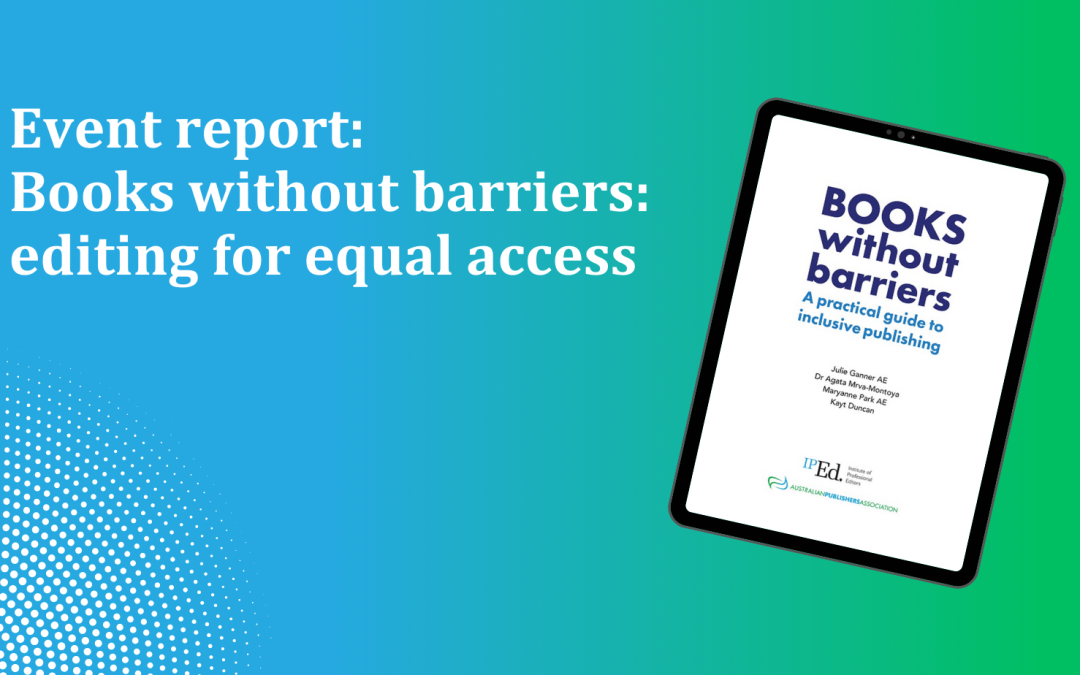Editors NSW welcomed Julie Ganner AE to our 2024 professional development series on Tuesday 6 February. Julie spoke to the importance and implementation of accessible editing practice in her presentation “Books without barriers: editing for equal access”.
Julie is IPEd’s representative to the Australian Inclusive Publishing Initiative (AIPI), a cross-sector forum that aims to increase access to published material for people living with print disability. Julie is also a member of IPEd’s Accessibility Initiative Working Party (AIWP) where, with Dr Agata Mrva-Montoya, Maryanne Park AE and Kayt Duncan, she co-authored Books without barriers, a comprehensive guide IPEd co-publishes with the Australian Publishers Association (APA).
Despite the global publishing industry’s increasing focus on accessible publishing, many texts are still partly or wholly inaccessible for some readers. Julie believes that all publishing professionals, including editors, have a responsibility to implement best practice in making texts more accessible.
Julie explained that print disability occurs when the design of a text limits or prevents individuals from accessing the information that it contains. Importantly, print disability does not just include vision impairments – access to printed material can be limited by physical conditions that make it difficult to use a traditional book; by cognitive conditions that make it difficult to perceive the way texts are traditionally written; and by a spectrum of vision-related conditions that prevent people from perceiving traditionally printed text. This list is not exhaustive, and Julie explained that there are countless situations where traditionally published texts are inaccessible to many people.
Despite huge technological advances, assistive technologies designed to remove barriers to access are only useful if texts are designed in a way that embeds these technologies throughout the publishing process to create “born-accessible” books; that is, books that are designed to be accessible from inception, rather than those that have accessibility features retrofitted after publication. Many accessibility barriers can be addressed at the editing stage of production by considering structure, style, image use, and language.
Julie said, “The first thing to consider is how to structure a manuscript.” While a traditionally published text might be easily navigated using contents lists, page numbers, indexes, and running headers, these features are of limited value to a reader with a print disability unless these elements can be perceived by readers or assistive technology. This means, for instance, using hierarchical headings, limiting list levels, and being conscious of how page design could affect those readers with limited visual acuity.
Style can also have a significant impact on a text’s accessibility, including how we use capitalisation, italics or bold fonts, punctuation, abbreviations, numbers, and even sentence structure. Julie said, “Try restructuring sentences to provide emphasis instead … be creative and consider how else you can render things like interior monologue.” Julie explained the use of minimal punctuation in reference lists. “It’s much less work for braille users to process … and less work for their transcribers too!”
“Another important consideration,” Julie said, “is how to convey the information in any images in your book, including the cover illustration, to readers who can’t see them.”
All assistive technologies require well-written image descriptions or meta-tags and these should be accessible in any format the text might take.
Finally, Julie prompted attendees to give thought to how an over-reliance on visual imagery might exclude those readers who do not have the experiences needed to make sense of the messages being conveyed, especially in the case of children’s books and instructive non-fiction. She said, “Avoid purely visual descriptions or examples that may be abstract or meaningless for children with low or no vision.” Julie encourages the use of all senses in the creation of imagery: touch, taste, smell, and hearing. She clarified that choosing accessible language was not intended to limit the use of imagery in creative forms such as poetry. Instead, editors and publishers could make decisions based on the intended purpose of the text.
There are still barriers preventing Australians from having equal access to published material, despite increasing accessibility initiatives and assistive technologies. It is essential editors continue to be creative in how they complete their work, and that they strive to find inventive solutions to cater to the different needs of all members of our communities.
Editors NSW thanks presenter Julie Ganner, and Zoom host Kai Jensen, for their time. Books without barriers is available for free download from the resources section of the IPEd website.

